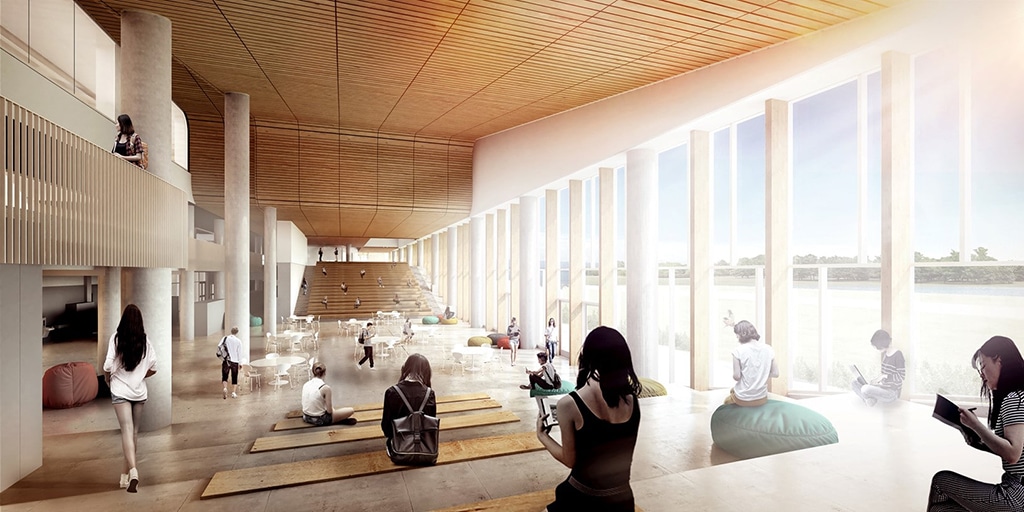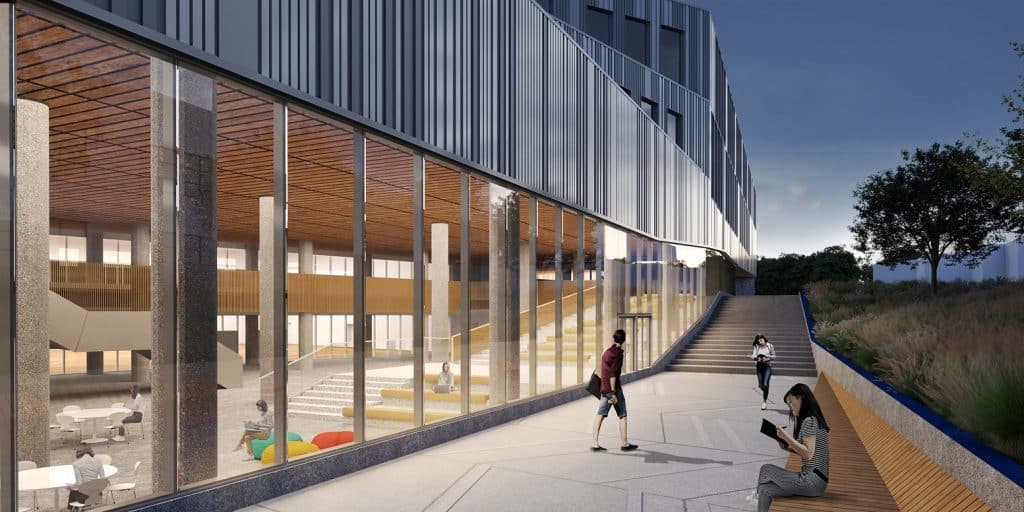What should the schools of tomorrow look like? How can design benefit the development of learning environments in the future? We’re often contemplating the possibilities both as architects and as parents, looking to develop new ways for schools to strengthen their connections with their surrounding communities.
What we’ve found time and again is a need for human and community-centered architecture, landscape and design that reinforces the value of education and connection, deepens schools’ belonging in the fabric of communities, and meet needs of future generations through sustainability.
Schools already play a major role at the heart of the community, and as we look to the future, we can see more and more opportunities to improve and expand their role in people’s lives.
Landmarks that represent belonging to students
 Students often spend more than 40 hours a week on school grounds, so it’s worth considering how the architecture and design of schools can positively influence how students mentally, physically, and emotionally develop. Space must foster their learning, and support the faculty behind that learning.
Students often spend more than 40 hours a week on school grounds, so it’s worth considering how the architecture and design of schools can positively influence how students mentally, physically, and emotionally develop. Space must foster their learning, and support the faculty behind that learning.
We can start by looking at the school’s place in a city, questioning its immediate relationship to both the various contexts that host it and the various potentials of its space which hosts others. By establishing a school that is better connected to its environment, we can foster community ownership within that school, becoming a place that is no longer an island but an involved and supportive part of its urban surroundings.
There is a need to establish where the “heart” of the school is, a public square that creates a sense of inclusion and pride: Imagine large and inviting amphitheatre-like gathering spaces to discover at schools’ entrances. Students and staff could take advantage of this open area for not only as places to collect and learn but also to rest or take social breaks between classes. This way, the heart of a school becomes the open and social soul of the space—we currently find that these kinds of spaces are only found in the margins of schools, hidden at the ends of corridors and often underused.
Finally, it’s essential that schools’ indoors are linked to the outdoors, where central plazas flow into that heart and lend to it becoming the focal point of each institution.
Reimagining space for sustainable use
Construction remains an important responsibility, but in building a legacy for future generations, the approach must be studied and measured. The schools of tomorrow can and should become agents of sustainability and their environmental impact can be mitigated through changes both big and small.
We can begin from the ground up, using locally sourced construction materials, integrating and preserving local vegetation and landscaping, using geothermal heating systems, or by reducing the footprint of buildings. No matter how many of these kinds of gestures are incorporated, each of them contributes to making tomorrow’s schools more responsible in minimizing their environmental impact.
Changes like these go beyond the promotion sustainability and environmental responsibility in schools as well, as they inspire greater eco-mobility strategies in their communities. Design elements that prioritize active travel by foot and bicycle can provide better access to green collective transportation. Schools are a place of convergence, connected to both their neighbourhoods and the multiple networks at large they are a part of.
Connecting schools with their communities

A school is so much more than halls of classrooms. As community hubs, it acts as a space for meaningful dialogue and cultural exchanges. The architectural design can reinforce these social aspects by creating adaptable environments that are integrated with its greater community.
A school can be an anchor, supporting the cultural, sports and social activities of its neighborhood. By creating a sustainable dynamic with its environment, a school contributes to the creation of tangible links and encourages a sharing economy.
A school can also be root structure, with connections branching out to a municipality’s network of green spaces and sports facilities to create an ongoing connection with its surroundings through physical and ecological links.
Take a look at how these aspirations for tomorrow’s schools can take shape with projects like Chambly Secondary School, Mirabel Secondary School, LaSalle Secondary School, and Laval Secondary School.
 Students often spend more than 40 hours a week on school grounds, so it’s worth considering how the architecture and design of schools can positively influence how students mentally, physically, and emotionally develop. Space must foster their learning, and support the faculty behind that learning.
Students often spend more than 40 hours a week on school grounds, so it’s worth considering how the architecture and design of schools can positively influence how students mentally, physically, and emotionally develop. Space must foster their learning, and support the faculty behind that learning.
